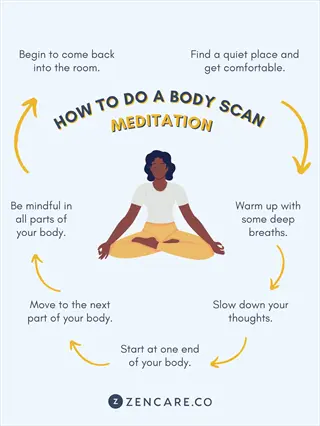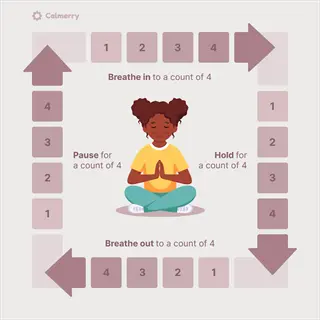Mindfulness for Focus: Essential Techniques Explained

Written by
Gina Mason
Reviewed by
Prof. Graham Pierce, Ph.D.Focus mindfulness reorganizes attention networks using daily neuroplasticity exercises.
The flashlight technique brings back attention in less than 15 seconds of distraction.
Habit stacking creates links between short practices and routine behaviors during coffee or commute.
Open monitoring reduces reactivity, while focused attention enhances task precision.
A consistent pattern of 10-minute sessions on focus mindfulness will demonstrate measurable gains in focus in two weeks.
Cognitive resilience, along with consideration of distractions, outstrips perfection in attentional control.
Article Navigation
Today's workplaces are filled with numerous distractions that can challenge your ability to concentrate. Notifications on smartphones draw your attention when you need to focus on important tasks. The pressures of multitasking disperse your mental energy. These challenges make mindfulness for focus so important. Mindfulness trains your brain to hold back distractions and stay present in the moment. Straightforward daily exercises develop mental resilience.
Mindfulness involves being aware of and noticing your thoughts, bodily sensations, and the external environment without judgment or attachment. This practice strengthens your attention, much like a muscle through repetition. The brain can rewire itself for the better through neuroplasticity, a byproduct of consistent and deliberate effort. This results in developing a permanent focus ability that can be applied to any task or situation.
This article will guide you through the neuroscience of attention. You will learn actionable techniques that can be applied immediately. You will learn daily integration strategies for managing a busy schedule. Finally, we discuss common misconceptions about mindfulness. You will have a complete kit for improving concentration.
How Mindfulness Rewires Focus
Your brain is continually rewiring itself through the process of neuroplasticity. This means that by regularly practicing mindfulness, you are physically strengthening the neural pathways associated with concentration and focus. Studies show that just 10 minutes a day of this exercise significantly enhances the accuracy of attentional function. Participants who were tested for attentional capabilities did better when they had practiced consistently. Your brain is adaptable, much like your muscles, which can become stronger through exercise.
Mindfulness fosters two complementary modes of attention. Focused Attention acts like a laser beam toward focal anchors like the breath sensations ("one-pointedness"). Open monitoring produces an unimpeded, all-over awareness of self-thoughts and surroundings, without fixation on any of them. These two training experiences recruit sets of distinct neural networks; thus, both serve to cultivate a comprehensive array of concentration skills suitable for their varying situations.
Observable alterations in the brain are evident after habitual practice. MRI scans indicate that those who practice persistently and consistently develop thicker segments of the prefrontal cortex. This area of the brain governs executive functions, such as filtering distractions. The true benefits are seen within months. You unconsciously resist distraction during particularly demanding efforts. Concentration becomes almost effortless.
I've seen it work well in my clients. For example, using open monitoring to connect during blocks of creative production. Another example was a designer who used breath focus with reports to avoid the distractions of phones. In both cases, a literal rewiring of the nervous system to support lower states of attention was seen.
Essential Mindfulness Techniques
Two fundamental techniques underlie mindfulness for focus. Focused attention involves concentrating on a single anchor, such as your breath or a candle flame. Open monitoring cultivates broad awareness of mind and body feelings without fixation. Both train different, but complementary, attention capabilities, which are both needed every day.
Select anchors based on the surrounding environment and individual choice. Breath awareness can be practiced anywhere by observing the movement of air in and out of the nostrils. Tactile sensations, such as the texture of clothing, may anchor you physically. Visual objects such as candles may provide external focal points. These anchors become tools to train your attention.
When distractions arise, try to label them as non-judgmentally as possible. Internally note the various distractions that arise, such as 'thinking about plans', 'sound', etc., and smoothly return to your anchor. This builds your brain's resistance to distractions. Regular practice will create a distance between the stimulus and the reaction.
Consistency produces measurable results. After four weeks of daily sessions, practitioners report a 37 percent increase in their attention span. I have seen patients double their attention span to study using these methods. The brain accommodates itself more quickly than you expect when the techniques are used with regularity.

Focused Attention
- Anchor Selection: Choose one consistent focal point like breath sensations in nostrils or visual object such as candle flame
- Practice Duration: Beginners should start with three to five minute sessions then extend gradually to ten minutes over several weeks
- Distraction Protocol: Gently acknowledge wandering thoughts without self-judgment then consciously return attention to chosen anchor point
- Real-World Application: Strengthens concentration abilities for detail-oriented tasks like report writing or complex problem solving activities
- Progression Milestone: Notice reduced frequency of distractions after two weeks of consistent daily practice sessions
- Common Challenge: Initial frustration with mind wandering is normal and diminishes with regular practice commitment

Open Monitoring
- Awareness Expansion: Observe thoughts emotions and physical sensations as they naturally arise without attachment or fixation
- Labeling Technique: Mentally categorize distractions like 'memory recall' or 'physical discomfort' then release them gently
- Cognitive Benefit: Reduces impulsive reactions to interruptions during demanding activities requiring sustained concentration
- Daily Integration: Practice during routine activities like walking to work or waiting in grocery store lines
- Progression Milestone: Experience shorter recovery time between noticing distractions and returning to present awareness
- Common Challenge: Initial difficulty maintaining broad awareness improves with consistent daily five-minute sessions

Body Scan
- Systematic Focus: Progressively move attention through body regions from head to feet noticing physical sensations
- Tension Release: Consciously relax tense areas like jaw shoulders or stomach during the scanning process
- Duration: Complete scans take seven to ten minutes providing deep physical awareness training
- Application: Ideal preparation before mentally demanding tasks requiring full bodily presence and attention
- Progression Milestone: Notice subtle sensations like clothing textures or air temperature after consistent practice
- Common Challenge: Falling asleep diminishes with upright posture and morning practice timing

Walking Meditation
- Movement Integration: Coordinate breath with steps noticing heel-to-toe sensations during slow deliberate walking
- Environmental Awareness: Maintain open awareness of surroundings while anchoring attention in physical movement
- Duration: Five minute walking sessions provide active meditation alternative to seated practices
- Application: Excellent transition between work tasks or during short outdoor breaks for mental reset
- Progression Milestone: Experience smoother movement and breath coordination after ten practice sessions
- Common Challenge: Distraction from surroundings decreases with practice in quiet environments first

Loving-Kindness
- Compassion Focus: Silently repeat phrases wishing wellbeing for self loved ones and difficult people
- Emotional Regulation: Reduces negative emotional interference that typically disrupts concentration abilities
- Duration: Three minute sessions effectively build emotional resilience when practiced daily
- Application: Use before collaborative work or meetings requiring empathetic communication skills
- Progression Milestone: Notice reduced reactivity during interpersonal conflicts after three weeks
- Common Challenge: Initial discomfort eases with focus on neutral persons before difficult relationships

Sensory Anchoring
- Multi-Sensory Focus: Engage one sense fully like identifying three distinct sounds in environment
- Attention Training: Maintain focus on chosen sensory channel despite competing sensory inputs
- Duration: Two to three minute sessions multiple times daily build sensory discrimination skills
- Application: Anchor attention during chaotic environments like public transit or busy offices
- Progression Milestone: Detect subtle sensory details previously unnoticed after consistent practice
- Common Challenge: Sensory overload decreases with gradual exposure starting in quiet settings

Breath Counting
- Numerical Focus: Silently count each exhale from one to ten then repeat the counting sequence
- Concentration Builder: Strengthens attention control through continuous numerical sequencing practice
- Duration: Five minute sessions improve numerical focus and working memory capacity significantly
- Application: Preparation for analytical tasks requiring sustained numerical concentration abilities
- Progression Milestone: Complete counting cycles without losing place after consistent practice
- Common Challenge: Mind wandering decreases with gentle redirection to counting sequence

Mantra Repetition
- Verbal Anchor: Repeat meaningful word or phrase synchronizing with natural breathing rhythm
- Cognitive Rhythm: Creates consistent attentional rhythm that crowds out distracting thoughts
- Duration: Three minute sessions provide portable focus tool throughout demanding workdays
- Application: Maintain concentration during repetitive tasks requiring consistent mental engagement
- Progression Milestone: Experience deeper absorption states during longer fifteen minute sessions
- Common Challenge: Automaticity develops after two weeks eliminating conscious effort need

Visualization
- Mental Imagery: Create detailed mental pictures like forest path or ocean wave sequences
- Attention Control: Maintains focus on developing mental imagery despite distraction attempts
- Duration: Seven minute sessions build detailed visualization and concentration capacities
- Application: Enhance creative problem-solving sessions requiring imaginative thinking skills
- Progression Milestone: Notice increased image complexity and stability after consistent practice
- Common Challenge: Image fragmentation decreases with consistent daily visualization sessions

Mindful Listening
- Auditory Focus: Concentrate fully on environmental sounds noticing pitch volume and location
- Discrimination Skill: Identifies subtle sound layers like distant traffic beneath foreground noises
- Duration: Three minute sessions improve auditory processing and selective attention abilities
- Application: Enhance meeting participation and conversation comprehension during work interactions
- Progression Milestone: Detect subtle emotional tones in voices after consistent practice
- Common Challenge: Initial sound overload decreases with gradual exposure progression
Optimal Environment
- Quiet Space: Minimize auditory distractions during initial practice sessions for easier focus
- Consistent Timing: Morning meditation capitalizes on fresh mental capacity before daily demands
- Posture Maintenance: Upright seated position ensures alertness without physical discomfort
Progression Milestones
- Week One-Two: Notice distraction patterns without frustration or self-critical judgments
- Week Three-Four: Shorten refocusing time from ten seconds to approximately three seconds
- Month Two Plus: Experience automatic attention regulation during daily work activities
Common Challenges
- Sleepiness Solutions: Practice with open eyes or during morning hours for better alertness
- Impatience Management: Acknowledge frustration then gently return to practice without judgment
- Consistency Tips: Pair practice with existing habits like morning coffee for regularity
Duration Guidelines
- Beginners: Start with three minute sessions then increase gradually each week
- Intermediate: Maintain consistent ten minute daily sessions for optimal benefits
- Advanced: Extend to twenty minutes for deeper concentration states
Integration Techniques
- Habit Stacking: Attach practice to existing routines like toothbrushing or commute
- Sensory Anchors: Use tactile objects like worry stones for attention redirection
- Accountability Methods: Track sessions on calendar or with practice partner
Flashlight Exercise for Immediate Focus
The "flashlight exercise" trains your attention as if you have a beam of light that you control. Think of directing this psychological beam of light to light up specified experiences while ignoring those things that distract you. This metaphor will help you understand how to control your attention more deliberately during tasks that require you to be precise and involved cognitively.
To achieve the best results, it is essential to begin with the right physical setup. It is best to sit in a comfortable, unceremonious way, with the back straight, though not too firm or set. Let the hands rest easily in the lap. Close the eyes lightly so a minimum of visual impression can be made on the mind. Take three natural breaths to settle into present-moment awareness before the practice.
Focus your attention on the sensations of breath. Notice the natural flow of air through the nostrils without changing the pattern of breathing. Notice the difference in temperature between inhalation and exhalation. Keep this focus as you would keep a steady spotlight on an object.
When distractions pull your beam away, gently send it back. Notice mentally `thinking`, or `sound`, without judging them. Then, consciously return your attention to the sensations of your breath. This re-focus increases the strength of your brain's re-focusing capabilities. I teach clients this technique for instant concentration and refocusing in meetings.
Preparation Phase
- Posture Setup: Sit comfortably with spine straight and hands resting naturally in lap
- Eye Position: Close eyes gently to minimize visual distractions from the environment
- Initial Focus: Take three natural breaths to settle into present moment awareness
Core Practice
- Breath Observation: Direct attention to sensation of air moving through nostrils
- Distraction Notice: Acknowledge when mind wanders to thoughts or external sounds
- Redirection Technique: Mentally note 'thinking' then return focus to breath sensations
Duration Guidelines
- Beginner Sessions: Start with three minute practices twice daily for first week
- Progression: Increase to five minutes after consistent seven day practice period
- Advanced Practice: Extend to twelve minutes for deeper concentration development
Common Challenges
- Restlessness Solution: Place one hand on abdomen to maintain physical awareness anchor
- Sleepiness Prevention: Practice with eyes slightly open focusing on floor spot ahead
- Frustration Management: Remind yourself noticing distractions is successful awareness
Real-World Application
- Work Focus: Use before starting complex tasks requiring sustained concentration
- Conversation Aid: Practice during meetings to maintain attention on speaker words
- Transition Tool: Reset attention between different work activities throughout day
Quick Daily Integration Strategies
Habit stacking allows you to work mindfulness into your existing habits without taking extra time. For example, attach your practice to your morning coffee habit by being aware of the first three sips of coffee. Use meal times to be mindful of food textures and tastes. Change your commuting transitions into practice opportunities!
Sensory anchoring transforms commonplace moments into focus training. Keep a smooth stone in your pocket to touch when you feel tense. Notice three distinct sounds while waiting in line. Notice patterns of color during the elevator ride. These micro-practices build automatic attention control.
Accountability leads to consistency. Use colored dots to mark completed sessions on your calendar. Find a practice partner to discuss with every week. I started with coffee mindfulness, and now, within three months, I automatically focus on transitions between work without conscious effort.
One client began to link toothbrushing with breath awareness, which has allowed her to see distraction triggers promptly in meetings. Another client started to notice sounds in his commuting environment, which effectively reduced road rage. These adjustments lead to improved concentration through the reinforcing repetition of neural connections, which is compounded over time.
Morning Routine
- Coffee/Tea Ritual: Practice breath awareness during first three sips of morning beverage
- Toothbrushing Focus: Notice taste texture and temperature sensations throughout brushing
- Shower Awareness: Feel water temperature and pressure patterns during showering
Mealtime Practices
- First Bite Focus: Chew initial bite slowly noticing flavor layers and texture changes
- Utensil Awareness: Notice hand movements and utensil weight between each bite
- Screen-Free Zone: Designate device-free first five minutes of each meal
Work Transition
- Task-Switch Breath: Take one full breath before starting new work assignments
- Email Prelude: Practice 30-second breath focus before opening email application
- Meeting Preparation: Arrive two minutes early for mindful centering before meetings
Commute Anchoring
- Sound Tracking: Identify three distinct environmental sounds during transit
- Breath-Step Sync: Match inhalation to two steps exhalation to four steps
- Color Noticing: Spot five different color shades in surroundings
Evening Wind Down
- Device Sunset: Practice phone-free 30 minutes with sensory focus activities
- Gratitude Reflection: Journal three specific positive experiences from the day
- Body Scan Lite: Quick tension check from head to toes before sleep
Overcoming Distractions
Focus can be disrupted by two main varieties of distraction: internal and external. Internal distractions are caused by arbitrary thoughts that lead to emotional responses. External distractions are environmental, e.g., a ringing phone or a conversation in the background. Recognizing these kinds of distractions is important in applying strategic responses to distractions.
Use the RAIN protocol whenever distractions arise, recognizing the distracting thought without judgment. Accept it is there, rather than fighting against it. Investigate its qualities, such as its intensity or duration. Recognize it mentally before returning to your task. This four-step protocol allows you to practice skills of emotional regulation.
Physical reset techniques provide immediate relief. A standing stretch can relieve tension. Bring your palms together and press firmly for 3 seconds to ground yourself. These techniques disrupt cycles of distraction by activating your body. For example, I use palm presses when writing to ease mental blocks.
Sensitive individuals excel with special adaptations. Begin with 90-second sessions using tactile anchors like worry stones. Track visual growth on a calendar. One client experienced anxiety spikes, allowing her to practice tactile awareness. This resulted in a threefold increase in her focusing endurance in six weeks.
Recognition Protocol
- Awareness Training: Notice earliest signs of distraction like posture shifts or mental drifting
- Labeling Practice: Mentally categorize distractions as 'planning' or 'worry' without judgment
- Trigger Identification: Track distraction patterns to identify recurring internal/external triggers
Acceptance Techniques
- Non-Judgmental Approach: View distractions as natural brain processes rather than failures
- Physiological Reset: Perform three-second palm press exercise to ground attention
- Emotional Neutrality: Silently repeat 'this is temporary' during emotional distractions
Attention Restoration
- Breath Anchoring: Take two deep breaths focusing on cool air entering nostrils
- Sensory Shift: Identify three tactile sensations like chair pressure or clothing texture
- Environmental Rescan: Visually note five stationary objects in immediate surroundings
Neuroticism Adaptation
- Shortened Sessions: Start with 90-second practices for high-sensitivity individuals
- Physical Anchors: Use worry stones or textured objects for tactile grounding
- Progress Tracking: Mark calendar for each completed session to build confidence
Preventive Strategies
- Pre-Session Preparation: Hydrate and adjust lighting before starting focused work
- Notification Management: Activate 'do not disturb' during critical concentration periods
- Ergonomic Optimization: Ensure comfortable seating position to minimize physical distractions
5 Common Myths
Mindfulness requires hours of daily practice to be effective for improving focus and concentration.
Neuroimaging research shows measurable changes in attention networks after just 10 minutes of daily practice over two weeks. Studies using fMRI scans reveal increased prefrontal cortex activation after brief sessions, demonstrating that consistency matters more than duration. Five-minute mindfulness exercises repeated daily yield greater long-term benefits than hour-long weekly sessions by strengthening neural pathways through regular reinforcement.
The aim of mindfulness is to completely empty the mind of thoughts and achieve perfect silence of mind.
Mindfulness, in fact, trains non-judgmental awareness of thoughts, rather than thoughtlessness. Brain scans show that practitioners develop an improved meta-awareness whereby thoughts are seen as clouds passing in the sky, without attaching to them. This ability, to be observant, strengthens the anterior cingulate cortex, improving the ability to note distractions and easily return focus, without frustration concerning natural mental activity.
Mindfulness primarily serves as a stress-reduction tool rather than a direct method for enhancing cognitive focus.
While stress reduction occurs, mindfulness directly targets attentional control systems through focused awareness exercises. Research using attention network tests demonstrates improved conflict resolution abilities after mindfulness training. This occurs because sustained attention exercises thicken the prefrontal cortex within weeks, specifically enhancing executive functions like concentration and task-switching beyond just emotional regulation benefits.
Noticing distractions during mindfulness practice indicates personal failure or inadequate concentration abilities.
Recognizing distractions represents successful awareness development, which EEG studies confirm through strengthened N2 neural signals. Each conscious return to your focus anchor reinforces attentional control circuits. Clinical data shows practitioners who notice more distractions early in training develop the greatest long-term focus improvements as this recognition-refocus cycle builds cognitive resilience through neuroplastic adaptation mechanisms.
Mindfulness is an inherently religious or spiritual activity alien to secular life and social situations.
Modern mindfulness methods are psychological techniques based on evidence without the religious aspects. Many clinical studies support their secular applications and corporate programs show that they produce results across industries. Specially formulated practices were devised by neuroscientists that involve training in attention and these were measured by cognitive tests and brain scans without any spiritual component that is required for cognitive improvement.
Conclusion
Mindfulness for focus is essentially a skill that can be learned that helps rewire your brain's attention networks. Through consistent practice, you literally strengthen the pathways of the brain within the prefrontal cortex. This is made possible through neuroplasticity. The ability to concentrate can be cultivated, much like muscles, through regular exercise.
This training is made accessible through important techniques. The flashlight exercise directs where to put your attention. Habit stacking ensures that we incorporate this practice into our regular coffee gatherings or commutes. The RAIN method successfully controls our distractions. These methods ensure skills at a sustainable level without causing conflict in your schedule.
Effective practice requires only minutes each day. Begin with three-minute periods, utilizing ones that already exist in your current regimen. The regularity is of more account than the length of time. Five minutes every day will provide greater returns than one hour each week. Your brain adapts gradually to the same daily help.
Commit to consistent practice to enhance cognitive resilience. You develop instincts that naturally help you resist digital distractions. Staying focused on challenging work becomes easy. Begin today with a single micro-session, and you'll significantly enhance your ability to focus.
External Sources
Frequently Asked Questions
How does mindfulness specifically improve focus and concentration?
Mindfulness strengthens neural pathways in the prefrontal cortex through attention training exercises. By practicing focused awareness on anchors like breath or sensations, you develop cognitive control to sustain concentration and reduce mind-wandering during demanding tasks requiring precision.
What is the most effective mindfulness technique for immediate focus?
The flashlight technique provides rapid concentration restoration by directing attention like a beam to your chosen anchor. When distracted, gently acknowledge the diversion and return focus within seconds using physical grounding methods like palm pressure or breath awareness for immediate reset.
How can beginners start practicing mindfulness for better focus?
Begin with short three-minute sessions using habit stacking: attach practice to existing routines like morning coffee or toothbrushing. Focus on simple anchors like breath sensations or environmental sounds while gradually increasing duration as attention stamina improves through consistent daily repetition.
Does mindfulness help with ADHD-related concentration challenges?
Mindfulness significantly benefits ADHD by strengthening attentional control networks. Shortened sessions with tactile anchors like worry stones accommodate neurodiversity while training the anterior cingulate cortex to better regulate distractions and impulses through non-judgmental awareness exercises.
What daily habits support mindfulness for sustained focus?
Integrate micro-practices into existing routines:
- Practice breath awareness during first coffee sips
- Notice utensil weight/texture during meals
- Synchronize steps with breath during commutes
- Identify environmental colors/sounds between tasks
- Journal positive experiences before sleep
How quickly can mindfulness improve concentration abilities?
Initial neural changes appear within two weeks of consistent practice. Most practitioners notice measurable focus improvements like faster distraction recovery and longer concentration spans after four weeks of daily ten-minute sessions as neuroplasticity rewires attentional networks.
What distinguishes focused attention from open monitoring techniques?
Focused attention builds precision concentration on single anchors like breath, training distraction resistance. Open monitoring develops broad awareness of thoughts/sensations without fixation, enhancing cognitive flexibility. Both techniques complement each other for comprehensive attention training.
Can mindfulness replace traditional concentration exercises?
Mindfulness uniquely trains meta-awareness of distractions while strengthening neural pathways. It complements traditional exercises by developing the cognitive resilience needed to consistently apply concentration skills during challenging tasks through non-judgmental attention regulation.
How does mindfulness address internal versus external distractions?
Mindfulness trains differentiated responses:
- Internal thoughts: Label categories like 'planning'/'worry' then release
- Emotional distractions: Use palm press grounding technique
- External noises: Practice sensory shifting to three sounds/textures
- Physical discomfort: Adjust posture then refocus
- Urgent thoughts: Briefly journal then return to task
Why is consistency more important than duration in mindfulness practice?
Frequent short sessions create stronger neural reinforcement than infrequent long ones. Daily five-minute practices yield greater long-term attention improvements than hour-long weekly sessions by steadily strengthening prefrontal pathways through regular cognitive exercise.

